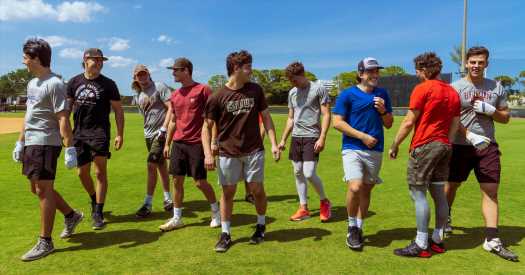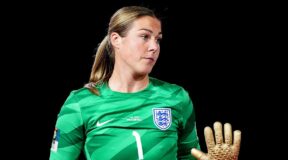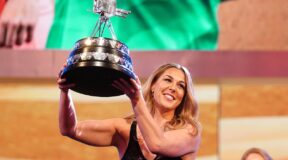PALM BEACH GARDENS, Fla. — Brown University’s baseball players returned to their Rhode Island campus in the dead of winter primarily because there was a sliver of hope for a season. Classes were remote, the athletic facilities were restricted and they had to quarantine for two weeks when they arrived in mid-January.
Still, after last season was all but wiped out because of the coronavirus pandemic, the players were desperate to play and hoped a season might begin in early March.
Pitchers stood mattresses up in dormitories and hurled weighted balls into them — the loud bangs eliciting warning texts from a resident adviser. Hitters followed suit, smacking baseballs off tees into their upright mattresses. The field was off limits, so on the days when it wasn’t too cold or miserable, the athletes played catch on a snow-covered green, doing their best not to strike passers-by.
Then, on Feb. 18, just as the N.C.A.A. Division I college baseball season was about to start, the Ivy League presidents announced that the conference’s spring sports seasons were canceled.
The Ivy League presidents were lauded a year ago for being the first in college sports to recognize the seriousness of the coronavirus. But their latest decision, at a time when vaccinations were ramping up and cases were retreating from a peak in reported numbers in January, highlighted what many Ivy League athletes hold as a discomfiting truth: that their years-in-the-making pursuits — and even career ambitions in sport — are viewed by administrators as an enrichment activity, something akin to dabbling in water colors or learning to play the piano for fun.
Losing a second season, or half a college career, to the pandemic was a crushing blow for the athletes.
It was made worse by the timing. While hundreds of Ivy League athletes — including droves of football players — have taken leave from their schools because of the conference’s archaic rules prohibiting graduate students from playing sports, Brown’s baseball players were already more than a month into the spring semester when their season was canceled.
Instead of letting their disappointment fester, the Brown players hatched a plan: Soon, they were on their way to Florida to continue another semester of remote learning and to train six days a week at a top-flight baseball site. Just because they couldn’t play games didn’t mean they couldn’t get better at the sport.
It didn’t take long for Gauge Lockhart, a freshman pitcher who drove from his home in Grand Junction, Colo., to realize this might not be a bad Plan B. When he walked into the workout area for the first time, there was Justin Verlander, the Houston Astros star pitcher, shirtless and dripping in sweat after a workout in his recovery from elbow surgery.
“I’m like, ‘What?’” Lockhart said.
His teammate Jacob Burley, a sophomore catcher, said: “It felt weird, like it wasn’t real. You’re sitting there rolling out and Justin Verlander, this dude you’ve watched on TV your whole life, walks by. I wanted to reach out and poke him.”
So, as the college baseball season carries on through the pandemic with every conference but the Ivy League, more than a dozen Brown players have traveled to Cressey Sports Performance’s metal-roofed warehouse that is set among several municipal baseball fields to reshape their bodies, rebuild their pitching and hitting mechanics, and play catch-up in a sport that demands repetition. Several Harvard players have joined them here, and a contingent of Yale players has traveled to Texas for a similar program.
The Brown players’ plan, not surprisingly, touched on familiar Ivy League tropes — resourcefulness, determination and, of course, privilege. (Four weeks of weight training and baseball instruction cost about $850; soft tissue massages, which run $60 per half-hour, are extra. The players got a discount on rent in a gated apartment complex because of a parent’s connection.)
“So many people don’t have the ability to do something like this at this time,” said John Torroella, a sophomore pitcher from Baltimore. He added: “Us being able to be here and have our families supporting us, we’ll undeniably be looking back on this as some of the best times of our lives.”
Mike Marra, whose son Ryan is a sophomore outfielder and first baseman from Commerce, Mich., outside Detroit, checked out the performance center this fall to see the training that he was investing in for his son. “It’s not like Ryan is going down there and having his T-ball coach throw him a few pitches,” he said.
If the pandemic has brought drastic changes in college sports — frequent testing, rigorous protocols, football games in all-but-empty stadiums, N.C.A.A. basketball tournaments held in centralized hubs — the Ivy League presidents have avoided the accompanying thorny ethical questions by nixing almost all intercollegiate competition.
It is one thing for the Ivy League schools not to chase billions in TV revenues as major college football and basketball schools did during the pandemic; it is another to avoid tapping into vast resources — in brain power and money — to play sports more safely because it conflicts with the ideal that athletes shouldn’t be treated differently from other students. (Ivy League presidents rejected a proposal this year by the Nets owner, Joseph Tsai, to fund a three-week, bubblelike tournament for Ivy lacrosse teams.)
The presidents said that if conditions improved, teams could play a limited schedule against local schools, something a handful of Ivy League teams have done. But such a schedule is so diminished that some have considered it pointless. The University of Pennsylvania is the only Ivy League school playing baseball this season, and it expects to play just 14 games — about one third of a usual season — and is not eligible for the postseason.
In a rare step, Grant Achilles, the Brown baseball coach, publicly criticized Ivy League leaders in a Twitter post several days after the decision. He took aim at their “lack of transparency,” said he doubted the presidents ever intended to have spring sports, and characterized their decision to offer a limited, local schedule as “a failure to understand” what being a Division I athlete entails.
Brown’s baseball players are not the only athletes at the school to feel marginalized. The school last year cut 11 varsity sports in a move that it said would better fund the remaining sports — though it eventually reinstated five of those sports after an intense lobbying effort by alumni.
The baseball players and their parents had further reason to be irked: Brown at first refused to refund their housing and meal payments for the in-progress semester, before relenting and refunding the balance of the meal plan, but not the payments made for housing. Those who moved out lost more than $3,000 in rent — a loss that made moving to Florida too prohibitive for some players.
“Brown is an amazing institution, but it’s an institution,” said Ilana Meyers, who helped arrange housing in Florida this spring for nine players, including her son Paxton, a freshman pitcher, and unsuccessfully urged the school’s vice president of residential life to provide a housing refund. “They were led to come back to campus because they thought there was a season,” Meyers said of the players. “If we had known there wouldn’t have been spring sports, he would have done a gap year.”
And yet the year has been far from a washout, the players said on a recent evening at one of the furnished apartments that Meyers helped them rent. Some pulled up chairs and others plopped down on a black faux-leather sofa to describe what this once-in-a-lifetime school year has been like.
Some had spent the year living out of a suitcase. One player had to rent a U-Haul truck when the pickup truck he bought in Florida in the fall broke down in South Carolina while he was on the way to visit his grandparents’ ranch in Missouri. Another, noting that his father wasn’t there to serve bacon and eggs for breakfast, had learned to cook. Yet another had to be reminded that the pasta box that he had emptied several days earlier wasn’t going to magically transport itself to the trash can.
They have discovered, as many college students do, that eating out costs a lot of money.
They have also gotten a sense of what it means to treat baseball like a job, working out four to five hours a day — and balancing it with their schoolwork, which they said required more self-teaching in the past year.
“I feel like I’m at least 25 now,” said Matthias Haas, a 19-year-old strong-armed, sophomore shortstop from Oakland, Calif., who on a recent Saturday night earned $90 in tips playing his guitar at a street corner in the nearby nightlife district.
Added Lockhart, the freshman pitcher: “Usually you go to school for four years and then you’re on your own. It’s kind of flipped.”
Burley, the catcher from Central California, typically wakes up by 9 a.m., checks his email, eats breakfast and makes the 20-minute drive to the workout center. He goes through a catalog of exercises prescribed from an intake examination, using foam rollers, bands, baseballs or mobility balls to help activate his quads, hip flexors, adductors, hamstrings, gluteus, calves, peroneals and virtually every other muscle that might be used to play baseball.
Sufficiently warmed up after 60 to 90 minutes, he runs through (depending on the day of the week) a potpourri of exercises like ice skater lunges, bowler squats, high knee skips, box jumps, side shuffles and sprints, and a variety of contortions.
“I’ve never felt more athletic in my life,” Burley said. “I want to get on a basketball court and dunk on people.”
In the afternoon, the work on his body is translated to the game. Burley catches pitchers who might range from high schoolers to his Brown teammates to minor leaguers. Sometimes they work against hitters in simulated games or in scrimmages. “I’m seeing guys that throw 95 with nasty breaking balls that college guys don’t have yet,” Burley said. “And I’m learning to read swings better, which has helped my pitch calling.”
Some days, he works in the batting cages on his swing.
By 3 p.m. Burley drives back to his apartment, showers, eats and turns his attention to school, attending classes that are mostly recorded and doing his homework until he goes to bed. The other players have followed a similar daily routine — except on Sundays, when they often go to the beach if they’re caught up on schoolwork — for nearly two months.
“It’s as if we’re taking a redshirt year to perfect our craft,” said Torroella, whose velocity has remained in the low 90s, but who has improved the spin rate and spin efficiency on his pitches.
There is still school, however. Torroella recently had an economics paper due on the failures in the 1970s of the Bretton Woods international monetary system. He hadn’t finished it before a live pitching session, so afterward he hunkered down in the waiting room for 90 minutes, putting the last touches on the paper and typing out citations on his laptop while his teammates pestered him to hurry so he could finish his workout.
“I was exhausted,” said Torroella, who turned in his paper with two hours to spare. He was given a high B, which he considered a win.
The graduate level learning for most players, though, has come in baseball.
The fitness instructors have helped them understand how their bodies function doing certain baseball movements — and how certain swing or pitch mechanics might be optimal. They also have access to modern diagnostic tools, including pitch-tracking cameras that spit out spin rates, movement, launch angles and exit velocity.
Then there is also ample opportunity to talk shop. If the Brown players are too deferential to approach major leaguers whom they have seen working out, like Verlander, Noah Syndergaard and Corey Kluber, the site has been an otherwise open baseball salon.
Ryan Marra, who stands 6-foot-5 and has bulked up to 250 pounds, last fall traded only-in-the-Ivy League banter with Kyle Hendricks, the Chicago Cubs pitcher who graduated from Dartmouth. But on a recent day, Marra was just as comfortable chatting between batting practice hacks with a pair of high school prospects or greeting a minor leaguer who entered the cages.
Light chatter might turn to tips for a pitch grip, a mechanical cue or coping with the game’s frustrations.
“It’s just one big community — that’s one of our favorite things about it,” Marra said at the apartment before excusing himself to study organic chemistry. “I’m not going to go up to Justin Verlander and say, ‘How ya doing today?’ But all the minor leaguers, you know them by their first name, you have conversations, you joke around.”
Still, the itch that hasn’t been scratched is playing competitive games.
That will come this summer when the players disperse to North Carolina, Massachusetts and Michigan to play in college leagues. And for all of the bonhomie and memories that have been created — along with the truly organic chemistry — they will start to go their own way.
Torroella is transferring to Michigan. Haas is leaving to play at Cal Poly San Luis Obispo. And Burley, a sophomore, is also considering a move. Two seniors, pitcher Collin Garner and center fielder Joe Lomuscio, plan to play elsewhere as graduate students next year, just as Garett Delano, who is starring as a two-way player at Mercer, and Richie Ciufo, the starting second baseman at Richmond, are doing this season.
Those were all players who had aspirations last year of leading Brown to its first Ivy League title since 2007.
“The night before I left, I was driving around with one of my friends pretty much bawling,” Haas said. “I didn’t know if that was the last time I was going to be on campus as a student.”
Ultimately, Haas, who started the season opener last year before injuring his shoulder, said that he couldn’t risk even more disruptions at Brown, and that returning closer to home would allow his father to attend every game. Haas, like all Ivy League freshmen and sophomores, will have four years of eligibility remaining.
Torroella had also expressed mixed emotions about leaving, but his teammates encouraged him to take advantage of a bigger stage and greater resources to chase his ambitions.
“Yes, there’s still a part of me saying, ‘I’d wish I’d stay at Brown and win some championships here and run off into the sunset,’” Torroella said. “But I should have some good opportunities ahead of me that should lead me to really good places. I’m betting on myself. I’m ready to take a leap.”
Source: Read Full Article






